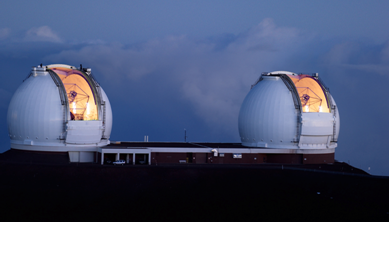- 1610: Galileo
- 1676: Ole Rømer
- 1687: Isaac Newton
- 1781: William Herschel
- 1838: Friedrich Bessel
- 1861: William and Margaret Huggins
- 1912: Henrietta Leavitt
- 1917 Einstein
- 1920: Harlow Shapley
- 1929 Edwin Hubble
- 1948: Ralph Alpher
- 1949: Fred Hoyle
- 1963: Maarten Schmidt
- 1964: Arno Penzias and Robert Wilson
- 1978: Vera Rubin and Kent Ford
- 1989: Margaret Geller and John Huchra
- 1992: John Mather and George Smoot
- 1995: Robert Williams
- 1998: Saul Perlmutter and Brian Schmidt
- 2010: Wendy Freedman
Keck 10-Meter Telescopes
The twin Keck telescopes on Mauna Kea, a dormant volcano on the large island of Hawaii, have mirrors 10 meters in diameters, and are at present the largest telescopes in the world. These telescopes were used by the two teams to both confirm their observations to determine for certain if they were type 1A supernovae and to measure their Doppler shift to measure the rate of expansion in the early universe.
 Cosmologist Jeff Cooke of the University of California, Irvine recently announced the discovery of the most-distant supernova ever observed using the Keck telescopes. The object is 11 billion light years distant, which means it exploded when the universe was just 2.7 billion years old.
Cosmologist Jeff Cooke of the University of California, Irvine recently announced the discovery of the most-distant supernova ever observed using the Keck telescopes. The object is 11 billion light years distant, which means it exploded when the universe was just 2.7 billion years old.